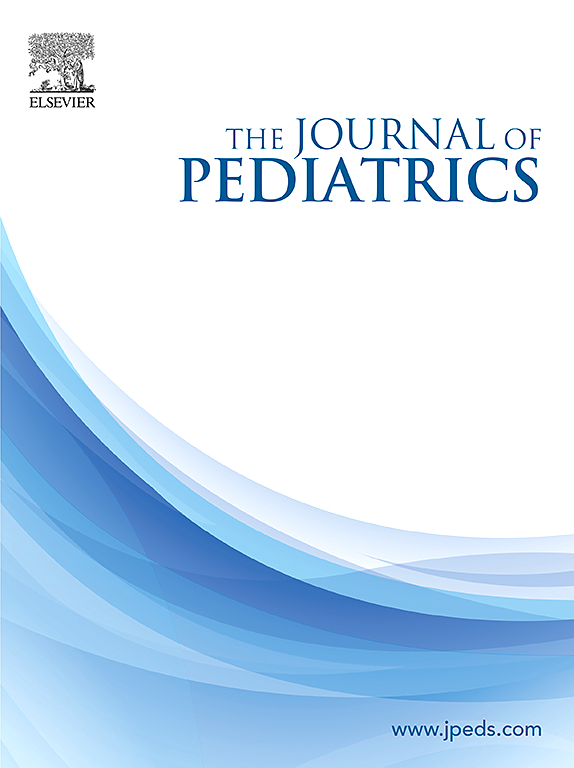A Randomized Controlled Trial of Commercially Available Virtual Reality for Intravenous Cannulation-Related Distress in Children
IF 3.5
2区 医学
Q1 PEDIATRICS
引用次数: 0
Abstract
Objective
To assess whether commercially available virtual reality (VR)-based distraction reduces distress when added to standard of care (SOC) for children undergoing intravenous insertion (IVI) in the pediatric emergency department.
Study design
Children aged 6-17 years requiring IVI were recruited for a two-arm randomized controlled trial. The primary outcome was child distress, measured using the Observational Scale of Behavioral Distress–Revised (score range 0-23.5). Secondary outcomes included children's procedural pain (verbal Numerical Rating Scale, score range 0-10) and fear (Children's Fear Scale, score range 0-4).
Results
Mean (SD) children age was 11.1 years (2.9) and 54% (45/82) were female. Mean (SD) preprocedural Observational Scale of Behavioral Distress–Revised scores were similarly low in both the VR [0.39 (0.70)] and SOC arms [0.18 (0.49)] (P = .16). Use of VR during IVI was not associated with lower mean (SD) total procedural distress [1.1 (1.5)] vs SOC [0.7 (1.4)] (P = .08), mean (SD) procedural pain intensity [3.0 (2.9)] vs SOC [2.1 (2.3)] (P = .14), or mean (SD) Children's Fear Scale score [0.97 (1.33)] vs SOC [0.97 (1.15)]. Technical issues with the VR equipment were reported in 26% (10/39) of cases.
Conclusions
VR distraction therapy employing commercially available software was not associated with reduction in procedural distress, pain or fear, above that provided with SOC, for children undergoing IVI in the pediatric emergency department. Given no differences and frequency of technical issues, other forms of distraction may be more appropriate in this setting.
Trial registration
Clinicaltrials.gov Identifier: NCT04291404.
市售虚拟现实治疗儿童静脉插管相关窘迫的随机对照试验。
目的:评估在儿科急诊科(ED)接受静脉注射(IVI)的儿童中,将市售的基于虚拟现实(VR)的分心添加到标准护理(SOC)中是否可以减少痛苦。研究设计:招募6-17岁需要静脉注射的儿童进行两组随机对照试验。主要结果是儿童痛苦,使用行为痛苦观察量表(OSBD-R,评分范围0-23.5)进行测量。次要结果包括儿童程序性疼痛(言语数值评定量表,评分范围0-10)和恐惧(儿童恐惧量表[CFS],评分范围0-4)。结果:平均(SD)儿童年龄为11.1岁(2.9岁),女性占54%(45/82)。手术前OSBD-R平均(SD)评分在VR组[0.39(0.70)]和SOC组[0.18(0.49)]同样较低(p = 0.16)。IVI期间使用VR与较低的平均(SD)总程序性痛苦[1.1 (1.5)]vs SOC [0.7 (1.4)] (P = 0.08)、平均(SD)程序性疼痛强度[3.0 (2.9)]vs SOC [2.1 (2.3)] (P = 0.14)或平均(SD) CFS评分[0.97 (1.33)]vs SOC[0.97(1.15)]无关。26%(10/39)的病例报告了VR设备的技术问题。结论:对于在儿科急诊科接受IVI的儿童,使用商用软件进行VR分心治疗与减少程序性痛苦、疼痛或恐惧无关,高于使用SOC。鉴于技术问题没有差异和频率,其他形式的分心可能更适合于这种情况。
本文章由计算机程序翻译,如有差异,请以英文原文为准。
求助全文
约1分钟内获得全文
求助全文
来源期刊

Journal of Pediatrics
医学-小儿科
CiteScore
6.00
自引率
2.00%
发文量
696
审稿时长
31 days
期刊介绍:
The Journal of Pediatrics is an international peer-reviewed journal that advances pediatric research and serves as a practical guide for pediatricians who manage health and diagnose and treat disorders in infants, children, and adolescents. The Journal publishes original work based on standards of excellence and expert review. The Journal seeks to publish high quality original articles that are immediately applicable to practice (basic science, translational research, evidence-based medicine), brief clinical and laboratory case reports, medical progress, expert commentary, grand rounds, insightful editorials, “classic” physical examinations, and novel insights into clinical and academic pediatric medicine related to every aspect of child health. Published monthly since 1932, The Journal of Pediatrics continues to promote the latest developments in pediatric medicine, child health, policy, and advocacy.
Topics covered in The Journal of Pediatrics include, but are not limited to:
General Pediatrics
Pediatric Subspecialties
Adolescent Medicine
Allergy and Immunology
Cardiology
Critical Care Medicine
Developmental-Behavioral Medicine
Endocrinology
Gastroenterology
Hematology-Oncology
Infectious Diseases
Neonatal-Perinatal Medicine
Nephrology
Neurology
Emergency Medicine
Pulmonology
Rheumatology
Genetics
Ethics
Health Service Research
Pediatric Hospitalist Medicine.
 求助内容:
求助内容: 应助结果提醒方式:
应助结果提醒方式:


